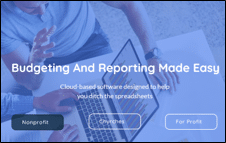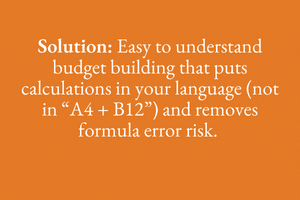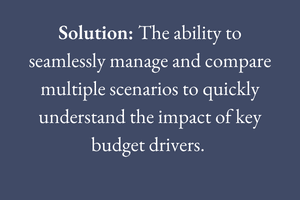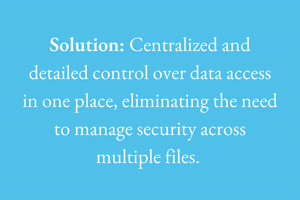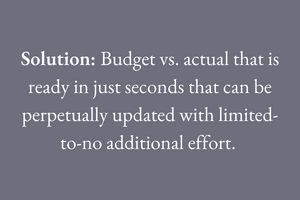October 13, 2021
By: Jim Norton, CPA
Microsoft’s Excel is the undisputed champion among the tools used historically by accounting and finance professionals. While Excel reigns supreme for quick one-off projects and projections, it does not support activities that contribute tremendous value to your organization in the form of strong governance, critical financial management, and enforcing accountability for financial or operational results. In fact, attempting to use Excel for these activities poses a major risk and does not position your organization to be nimble and strategic.
Even before the pandemic, many organizations had already embarked upon a digital transformation journey because they realize the limitations of their reliance on tools like Excel. These on-premises and “unconnected” tools are missing the tremendous benefits of cloud-based solutions that improve efficiency and accessibility across areas such as time and expense, financial and operational reporting, and even more nuanced needs like allocation calculation and posting. Yet despite their commitment to digitally transforming their organization, many accountants still rely on Excel for budgeting and planning. If your organization is still using Excel to develop budgets, you may not be aware of the opportunities you and your leadership team are missing.
The Challenges with Spreadsheet Budgeting
With finances driving much of what the organization does, the budgeting and planning function provides organizations with a clear roadmap for where they’re going and how they’re going to get there. If the plan includes expanding your service team, how will you cover the cost of new employees, and/or what level of profit should you expect? Many organizations use Excel to plot various scenarios that help leadership determine how and when revenue will be achieved and project the appropriate timeframe for new hires. Unfortunately, with 20 or more inputs and calculations needed to answer these questions, the likelihood of human error and faulty conclusions is high.
Dreaded Formula Errors
Many of the problems associated with spreadsheet budgeting come down to formula errors. When organizations use Excel for budgeting and planning, they often develop a multi-tab spreadsheet with multiple inputs and linked formulas between worksheets. If someone adds a row or a column and does not update the formula, the data is incomplete, and the organization is now using inaccurate data to make important financial decisions. Even organizations with savvy Excel users often find themselves in a hunt for the broken formula that wastes time and delays decision-making.
“What If” Scenario Planning
For most organizations, budgeting is a complex process requiring management of several scenarios. Answering “what if” questions is the key to understanding the impact to your bottom line from fluctuations in revenue throughout the year, for example. Managing budget scenarios in Excel requires multiple versions of the same workbook causing risky version control issues. Also, with the
accounting team managing multiple scenarios in Excel, valuable time is lost before leadership arrives at the final approved budget.
Security
Not all data is created equal. With Excel-based budgeting there is always the risk that sensitive information on employee compensation, for example, could be inadvertently shared with the wrong people. Similarly, large budget spreadsheets typically contain information for all departments across the organization. The information in these spreadsheets may not just be sensitive, it may be difficult for leaders to sift through the data they need to make important decisions. With security and ease-of-use in mind, many organizations work around this issue by creating a separate Excel file to share with each department lead and then consolidating them back into a master spreadsheet again for leadership. The security of your organization’s budget data should not be risky or time-consuming.
Budget vs. Actual
A budget is not meaningful unless you can measure it against actual results. Unfortunately, many organizations continue a time-consuming process of comparing actual results to a budget spreadsheet. This often entails accounting or finance team members gathering, reviewing, and reformatting actual data over several days before it can be compared side-by-side with the Excel budget for analysis and discussion. If the goal is to understand where the organization stands at a moment in time, any delay affects the accuracy of the data.
Modernizing Your Organization’s Budgeting and Planning
A Space with Many Options
There are many budgeting and planning solutions available in today’s market, but not all of them are created equal. If your organization is ready to take things to the next level by investing in a modern budgeting and planning solution, there are several questions you should first consider.
- Will this solution use the same chart of accounts/dimensions/tags format in my accounting system?
- Can this solution automatically digest the actual results from my accounting system?
- Can we perform some level of budget vs. actual reporting in this budgeting and planning solution?
- Can this solution restrict data visibility to team members on a “need to know” basis?
- Can this solution handle at least moderately complex modeling and calculations to support budget numbers?
- Can this solution easily handle multiple versions/scenarios/revisions without requiring someone to rebuild our budget from the ground up each time?
- How much will this solution reduce or eliminate our reliance on Excel or other spreadsheet tools?
A Cut Above the Rest
While many of the tools on the market are helpful, some are more dynamic and user-friendly making them superior budgeting and planning solutions.
Sage Intacct Budgeting and Planning
Current Sage Intacct customers should consider Sage Intacct Budgeting and Planning (SIBP), an easy-to-use, integrated solution that includes all the features mentioned above. Implementation often takes as little as one week and end users like UNITI, Semiahmoo House Society, and Red Door Interactive are satisfied customers. Take a product tour to learn whether SIBP is the right solution for your organization.
Martus Solutions
Those looking for a more software-agnostic solution (not tied to a specific accounting software) should consider Martus Solutions. Their long history of success is based on a seasoned solution offering automatic integrations with a variety of accounting software tools and easy “file-based” (import/export) solutions for others. For more on the seamless, value-added experience of Martus Solutions, watch a brief demo.
Contact
GRF’s Accounting Technology Services (ATS) team offers clients only the best software products on the market today combined with our superior service and expertise. Our experienced team provides complete solutions for clients based on their unique needs. When your organization has outgrown QuickBooks and other software products, you can be assured that GRF will match your organization with the right tools to get the job done. Our partnerships with solutions like Sage Intacct and Martus Solutions allow GRF to offer world-class solutions to support the business goals of our clients.
We pride ourselves on collaborating with clients, working side-by-side to help them reach their goals. To discuss how you can improve your organization’s budgeting and planning process, contact the Accounting Technology Services Team.


